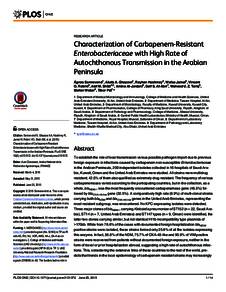Document
Genetic support of carbapenemases in double carbapenemase producer klebsiella pneumoniae isolated in the Arabian Peninsula.
Identifier
DOI: 10.1556/030.65.2018.005
Source
Acta Microbiologica et Immunologica Hungarica. v. 65, 2, p. 135-150
Contributors
Country
Hungary
City
Budapest
Publisher
Akademiai Kiado ZRt.
Gregorian
2018-06-01
Language
English
Subject
English abstract
Enterobacteriaceae co-producing NDM- and OXA-48-type carbapenemases were encountered in higher frequency in the United Arab Emirates (UAE) than in the neighboring countries in our earlier study. The aim of this investigation was to characterize the seven double carbapenemase producer Klebsiella pneumoniae found in the region to assess factors contributing to their emergence. Three K. pneumoniae ST14 isolated in the UAE harboring blaNDM-1 on IncHI1b and blaOXA-232 on IncColE plasmids were clonally related. Furthermore, two K. pneumoniae from the UAE, ABC106 and ABC137 belonged to ST307 and ST1318, respectively. ABC106 carried blaNDM-1 on IncHI1b, and blaOXA-162 on IncL/M plasmids, whereas ABC137 possessed blaNDM-1 on IncX3 and blaOXA-48 on IncL/M plasmids. The double carbapenemase-producing K. pneumoniae from Oman (OMABC109) and Saudi Arabia (SA54) belonged to ST11 and ST152, respectively. OMABC109 harbored blaNDM-1 on an IncHI1b plasmid highly similar to the NDM-plasmid of ABC106 and carried a chromosomally coded blaOXA-181 located on Tn2013. SA54 possessed a blaNDM-1 on an IncFIb/FII plasmid and a blaOXA-48 on an IncL/M plasmid. Based on these findings, clonal spread and horizontal transfer of carbapenemase genes located on transposons or self-transmissible plasmids contributed equally to the emergence of double carbapenemase-producing Enterobacteriaceae in the region.
ISSN
1217-8950
Category
Journal articles


